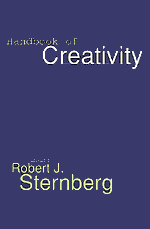Book contents
- Frontmatter
- Contents
- List of Contributors
- Preface
- Handbook of Creativity
- PART I INTRODUCTION
- PART II METHODS FOR STUDYING CREATIVITY
- PART III ORIGINS OF CREATIVITY
- PART IV CREATIVITY, THE SELF, AND THE ENVIRONMENT
- PART V SPECIAL TOPICS IN CREATIVITY
- PART VI CONCLUSION
- 22 Fifty Years of Creativity Research
- Author Index
- Subject Index
22 - Fifty Years of Creativity Research
Published online by Cambridge University Press: 05 June 2014
- Frontmatter
- Contents
- List of Contributors
- Preface
- Handbook of Creativity
- PART I INTRODUCTION
- PART II METHODS FOR STUDYING CREATIVITY
- PART III ORIGINS OF CREATIVITY
- PART IV CREATIVITY, THE SELF, AND THE ENVIRONMENT
- PART V SPECIAL TOPICS IN CREATIVITY
- PART VI CONCLUSION
- 22 Fifty Years of Creativity Research
- Author Index
- Subject Index
Summary
Approximately 50 years ago, Guilford (1950) revived interest in what was then the neglected field of creativity research by offering a compelling rationale and research agenda. In many ways, the Handbook of Creativity represents a progress report on how the field of creativity research has developed over the past 50 years. Within its 20 substantive chapters, the Handbook contains summaries by leading creativity researchers representing a seemingly chaotic diversity of research methodologies and questions.
How is creativity different from intelligence? How can we measure a person's creativity? Which cognitive processes are involved in creative thinking? How does a creative product happen? Which life experiences produce a creative person? What are the characteristics of creative people? What motivates creative people? What are the biological and evolutionary bases of creativity? How do social and cultural contexts affect creativity? Is creativity the dominion of an elite few or can everyone be creative? How does creativity develop? Can people learn to become more creative? These are the kinds of questions addressed in this volume.
These are deep questions that require creative research methodologies. Although the Handbook summarizes some important steps in answering these questions, the ongoing challenge for creativity researchers is to create new and useful research methodologies. In this chapter I explore two research issues underlying an agenda for creativity research - what to study and how to study.
- Type
- Chapter
- Information
- Handbook of Creativity , pp. 449 - 460Publisher: Cambridge University PressPrint publication year: 1998
- 43
- Cited by



